
Fish Monitoring
The Bureau of Freshwater and Biological Monitoring (BFBM) administers several fish monitoring programs to assess the status of designated uses in state waters as required by the Clean Water Act (CWA) section 305(b). These programs include the Fish Index of Biotic Integrity (IBI) programs (Northern Fish Index of Biotic Integrity, Southern Fish Index of Biotic Integrity and Headwaters Index of Biotic Integrity), Environmental DNA (e-DNA) monitoring program and the Fish Tissue Monitoring program.
Check out our interactive Fish Mapper!
The federal Clean Water Act (CWA) section 106 (e) (1) requires states receiving water grants to monitor the quality of their waters, including biological monitoring. The U.S. EPA’s National Guidance on the elements of a State Water Monitoring and Assessment Program suggest states should be using at least 2 biological community assemblages (e.g. , fish and macroinvertebrates) as core indicators to assess aquatic life use.
In 2000 the Bureau of Freshwater and Biological Monitoring (BFBM) initiated the fish index of biotic integrity (IBI) monitoring in the northern part of the state to assess the health and condition of fish assemblages and to identify potential stressors from high gradient streams in New Jersey. The Fish IBI is an index that measures the health of a stream based on multiple attributes (metrics) of the resident fish assemblage. Each site sampled is scored based on its deviation from reference conditions (i.e., what would be found in an unimpacted stream) and is subsequently classified as “very poor”, “poor”, “fair”, “good” or “excellent”.
The monitoring of stream fish assemblages is an integral component of many water quality management programs, and its importance is reflected in the aquatic life use support designations adopted by many states. Fish assemblages can be stand-alone indicators of a waterbody’s health and/or fishability. In addition, they may be combined with other biological and chemical indicators to assist in the identification of waters for upgrade to Category One antidegradation classification (N.J.A.C. 7:9B) based on exceptional ecological significance.
Currently, BFBM employs three IBI programs to monitor wadeable streams throughout the State. The northern fish IBI (NIBI) is used to assess high gradient streams north of the fall line which are greater than 4-square miles in drainage size. The southern fish IBI (SIBI) was developed for low gradient streams located in the Inner Coastal Plain which are greater than 2-square miles in drainage size. Recently, the bureau completed the headwaters IBI (HIBI) for those small high gradient tributaries north of the fall line which are less than 4-square miles in drainage size. The headwater IBI monitors the assemblage of fish as well as crayfish, salamanders and frogs to assess aquatic life use in small headwater streams.
Fixed sites are sampled on a five year rotating basis, with monitoring focused on one water region each year. Northern IBI and Headwaters IBI monitoring occurs in three (Upper Delaware, Northeast, and Raritan) of the State’s five major Water Regions on a rotational schedule of once every five years. Southern IBI monitoring occurs in one (Lower Delaware) of the State’s five major Water Regions on a rotational schedule of once every five years.
The Fish Monitoring program also includes Fish Tissue Monitoring to support fish consumption use assessments and advisories.
For all FIBI results/data, view Site Data
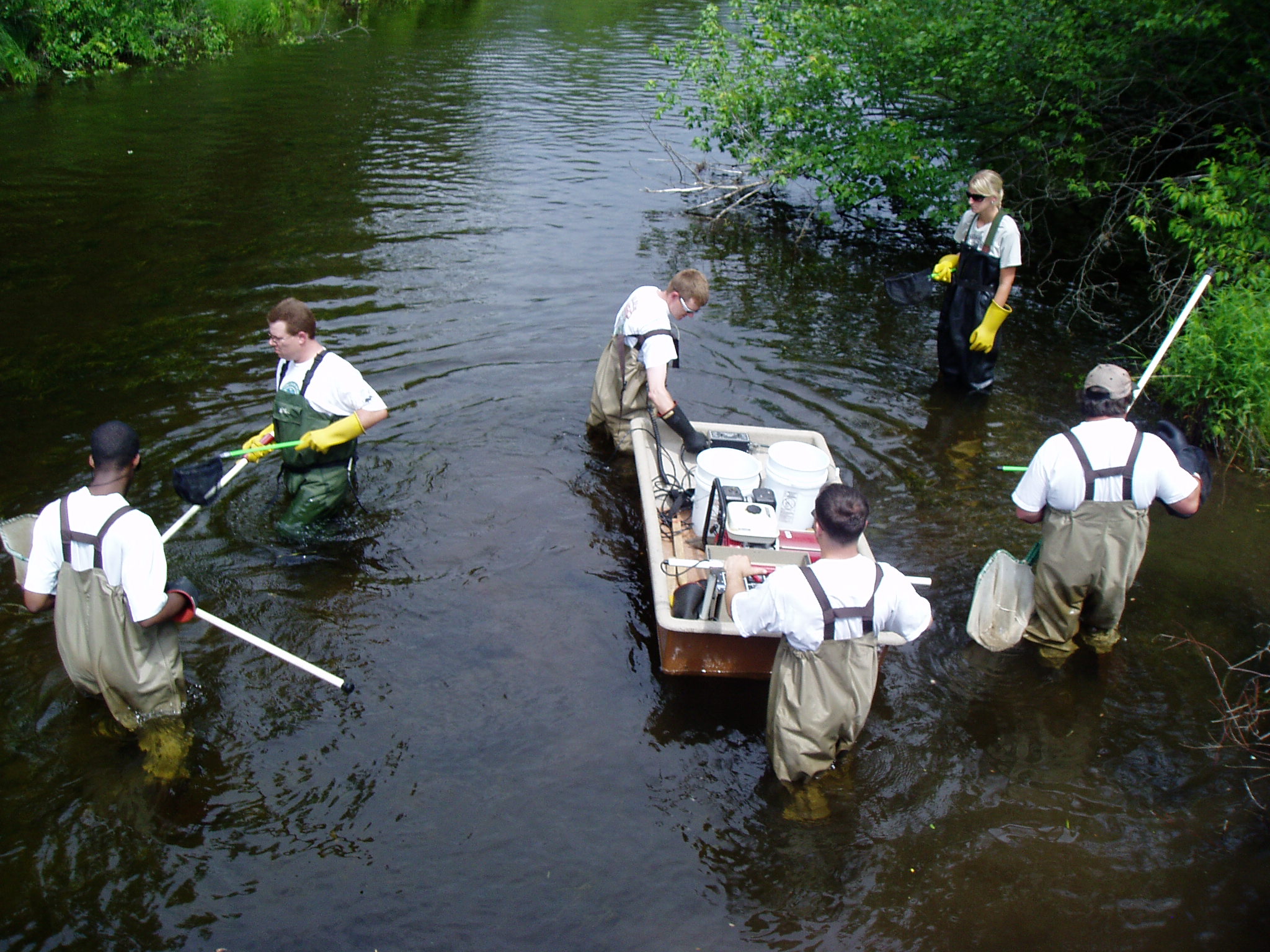
The Fish Index of Biotic Integrity (IBI) programs assess the health and condition of fish assemblages (additionally crayfish, salamanders and frogs in headwater streams) and identify potential stressors that may impact stream habitat or biota in streams of the State. The Fish IBI is an index that measures the health of a stream based on multiple attributes (metrics) of the resident fish assemblage. Each site sampled is scored based on its deviation from reference conditions (i.e., what would be found in an unimpacted stream) and is subsequently rated as “very poor”, “poor”, “fair”, “good” or “excellent”.
Northern Fish IBI (High Gradient)
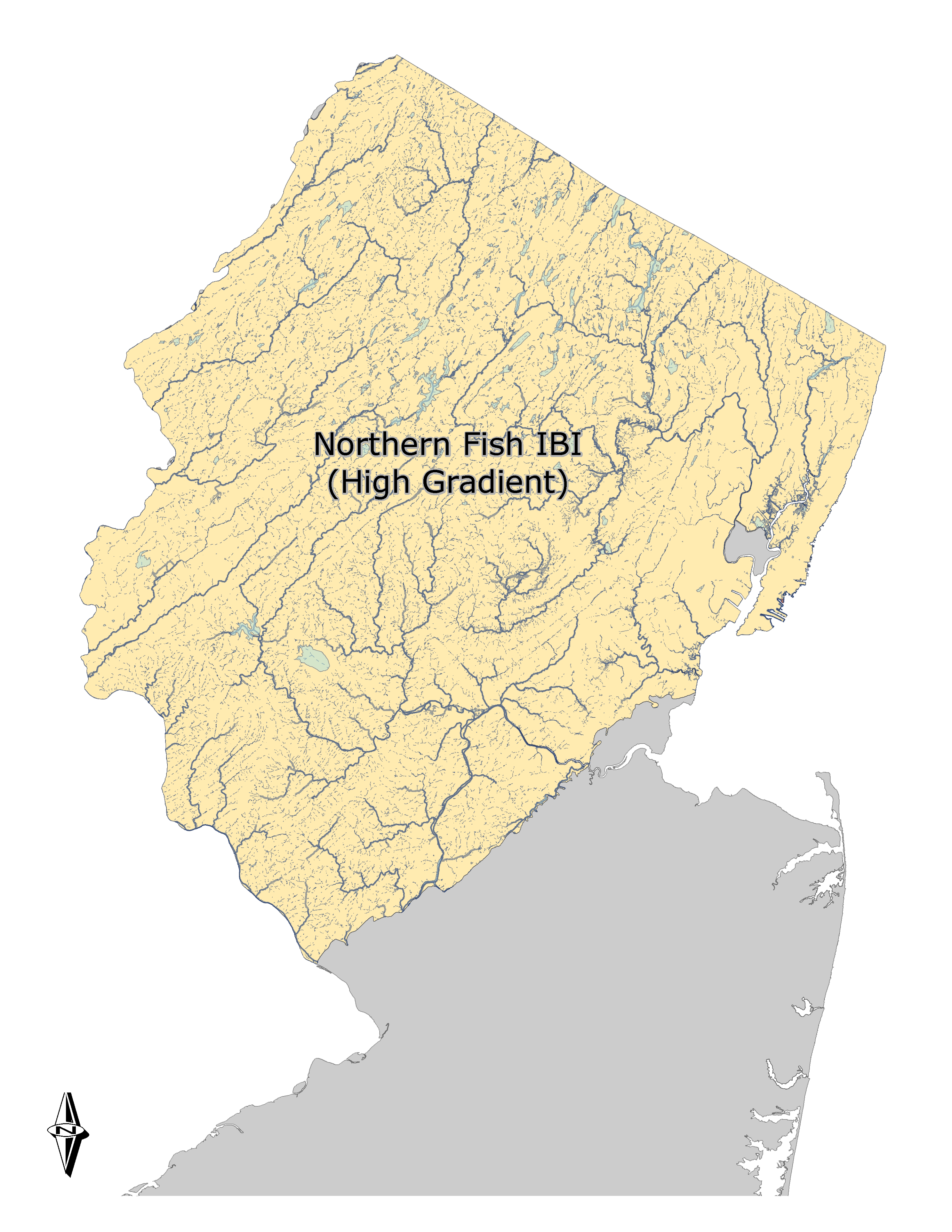
The Fish IBI data is used in concert with available macroinvertebrate data to assess the status of aquatic life designated use in state waters as required by the CWA section 305(b) 106 (e) (1). These data are used to identify impaired waters under section 303(d) 106 (e) (1). The data help to measure water quality use attainment and the Department's success in attaining the Clean Water Act goal of "fishable" waters as elaborated in the New Jersey Integrated Water Quality Assessment Report.
The IBI incorporates richness, trophic composition, abundance, and overall health of the fish assemblage into a single ecologically based index. The index is comprised of several attributes (metrics) of a healthy fish assemblage, which are selected based on their sensitivity to anthropogenic impacts. Each metric is scored based on its deviation from reference condition. Metrics are averaged to generate an overall score and rating for each stream sampled. Fixed sites are sampled on a five year rotating basis, with monitoring focused on one of the State’s five major Water Regions each year.
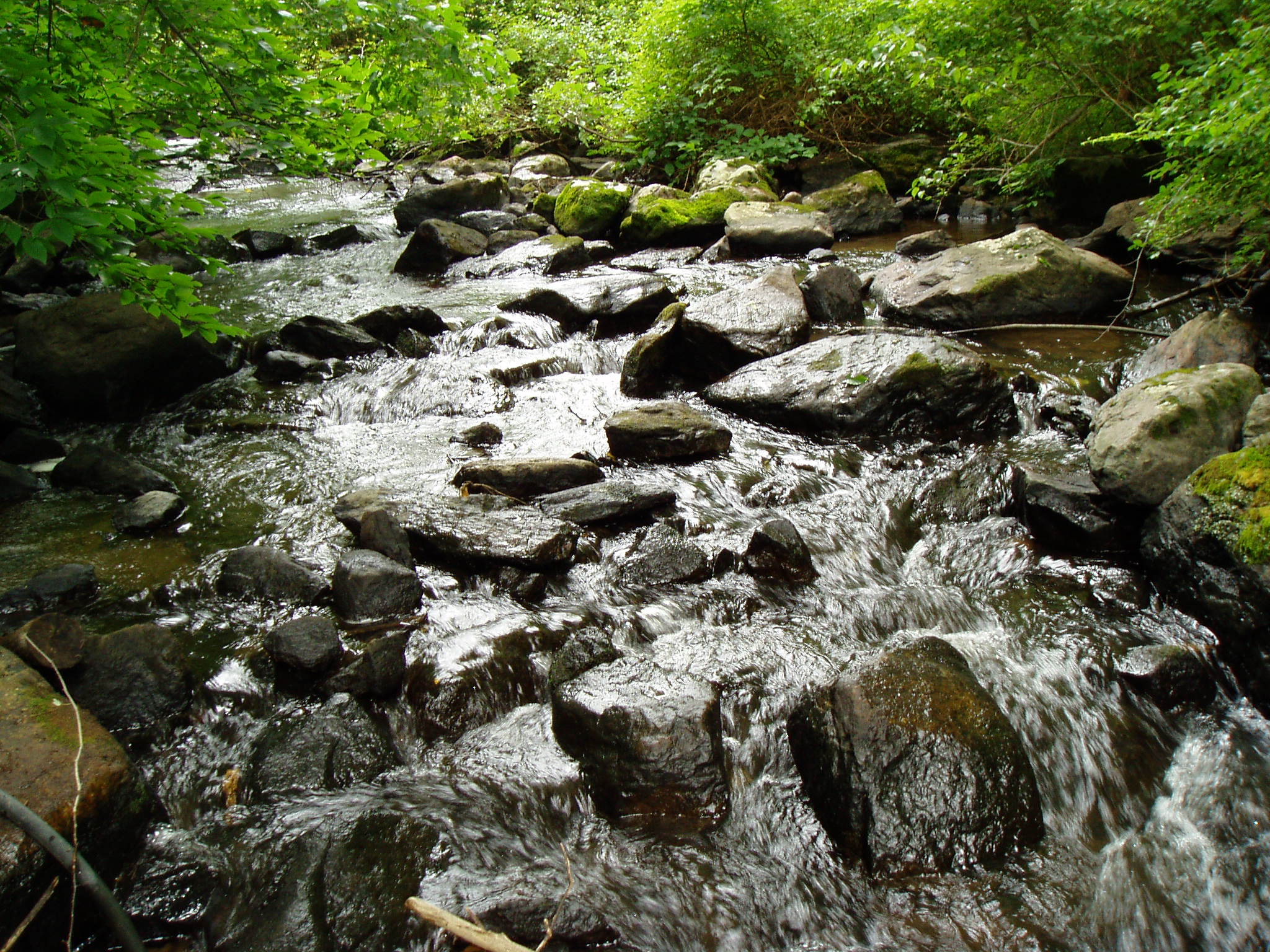
The northern fish IBI (NIBI) uses resident fish assemblages to measure the health of high gradient wadable streams north of the fall line which are greater than 4 square miles in drainage size. The Fish IBI data is used in concert with available macroinvertebrate data to assess the status of aquatic life designated use in state waters as required by the CWA section 305(b) 106 (e) (1). These data are used to identify impaired waters under section 303(d) 106 (e) (1). The data help to measure water quality use attainment and the Department’s success in attaining the Clean Water Act goal of “fishable” waters as elaborated in the New Jersey Integrated Water Quality Assessment Report. Fish assemblage analysis is accomplished using a regional modification of the original IBI (Karr 1981), developed by Kurtenbach (1994) and later recalibrated several times by the Bureau of Freshwater and Biological Monitoring (BFBM) (2005, 2013, and Vile and Henning, 2018).
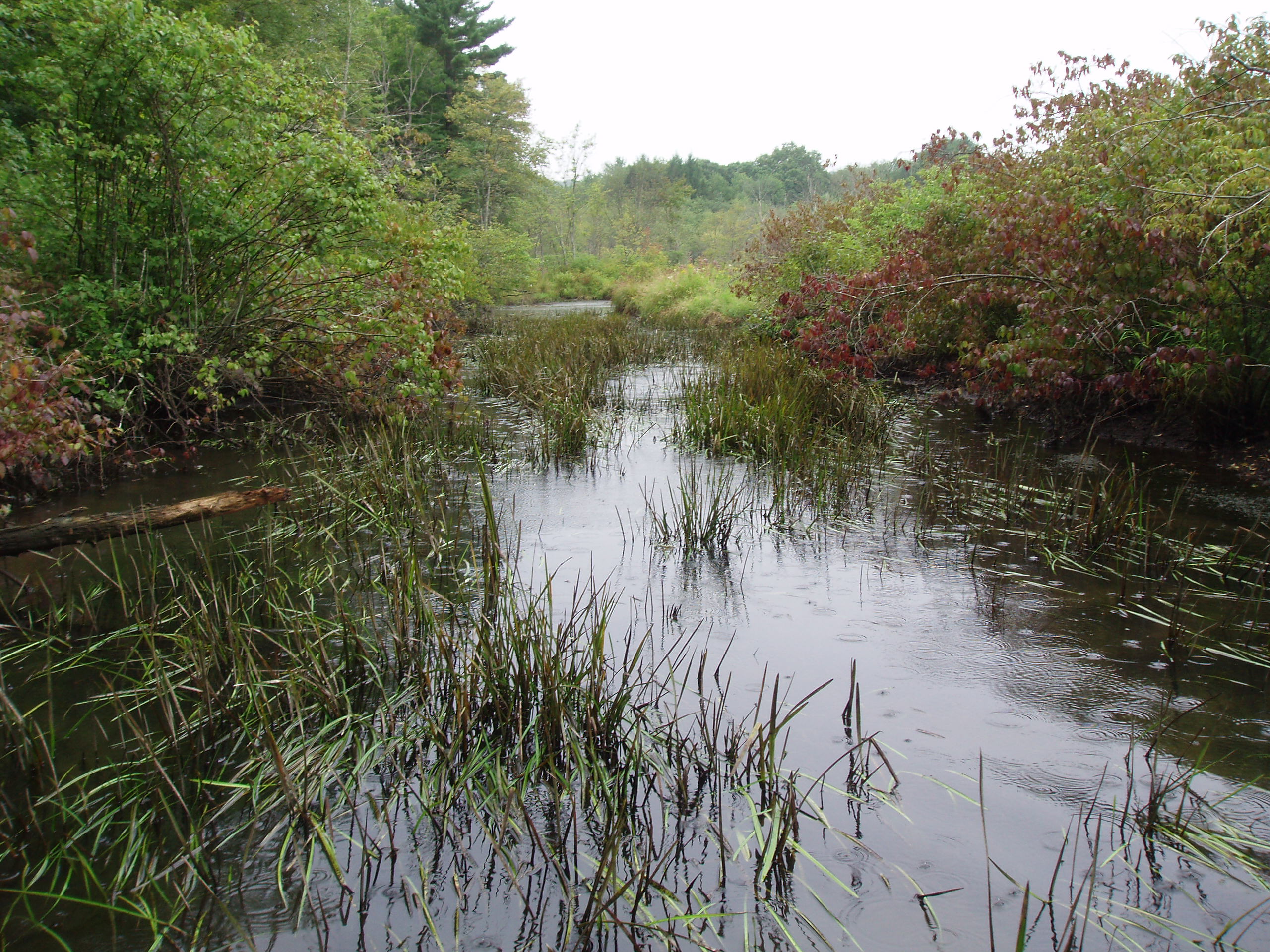
Fixed sites are sampled on a five-year rotating basis, with monitoring focused on one of the State’s five major Water Regions (Atlantic Coastal, Lower Delaware, Northwest, Raritan and Northeast) each year. Northern fish IBI monitoring occurs in the Northwest, Northeast and Raritan water regions. Sentinel sites are considered high quality waterbodies located in fully or partially protected watersheds which are sampled on a routine basis to assess environmental changes, natural variability through time, and to evaluate trends in NJ streams. Probabilistic sites are important for assessing aquatic life use in the waters of New Jersey. Probabilistic sites are selected using USEPA probabilistic site selection methodology (Generalized Random Tessellation Stratified (GRTS) survey design).
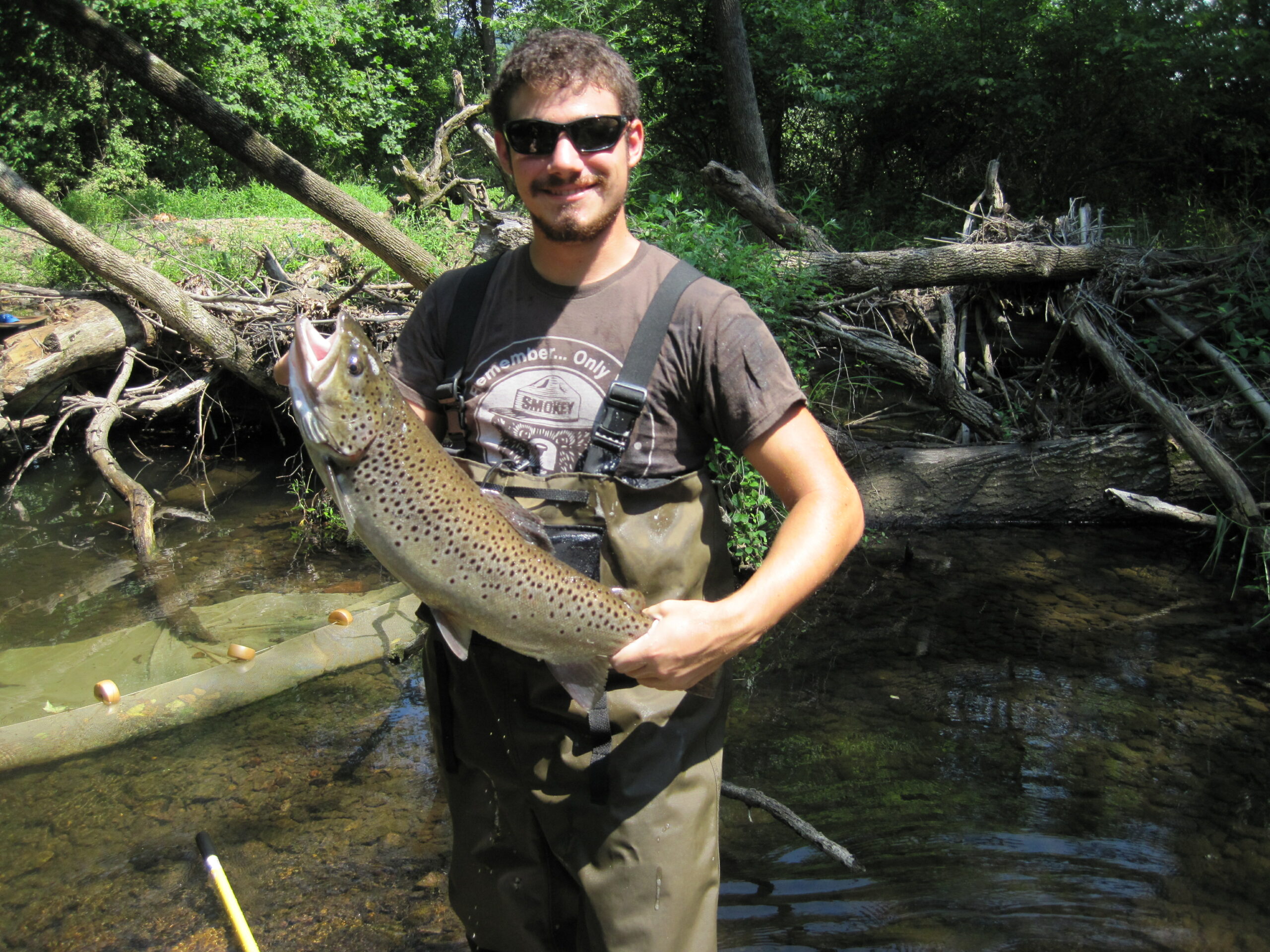
Detailed information related to the methods used to collect fish assemblage, chemical, and physical habitat data for northern high gradient streams can be found in the Fish Monitoring Standard Operating Procedures (SOP) . This document provides information on fish metrics and the associated scoring methodology for the Northern Fish IBI. In addition, the SOP outlines safety training and procedures as it pertains to electrofishing in wadable streams.
A summary of the sample types collected from this program include:
| Metric | Ecological Class | Response to Stress | Scoring |
| % Rheophilic Species* | Stream Flow |
Decrease | (Adjusted Value/27.19)*100 |
| % Coldwater & Nontolerant Coolwater Species** | Thermal | Decrease | (Adjusted Value/85.53)*100 |
| % Generalist Feeders* | Trophic | Increase | ((78-Metric Value)(49.62))*100 |
| Tolerance Index | Tolerance | Increase | ((9.32-Metric Value)(4.84))*100 |
| % Lithophilic Spawners* | Reproduction | Decrease | (Metric Value/69.02)*100 |
| % Cyprinidae** | Composition | Decrease | (Adjusted Value/75.29)*100 |
| % Dominant 3 Taxa** | Composition | Increase | ((92.39-Metric Value)(63.46))*100 |
| % Benthic Insectivore Species* | Habitat | Decrease | (Metric Value/37.75)*100 |
Fish and Headwaters Index of Biotic Integrity with John Vile and Brian Henning, NJDEP research scientists
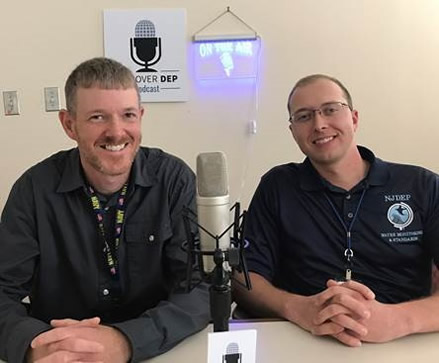
Southern Fish IBI (Low Gradient)
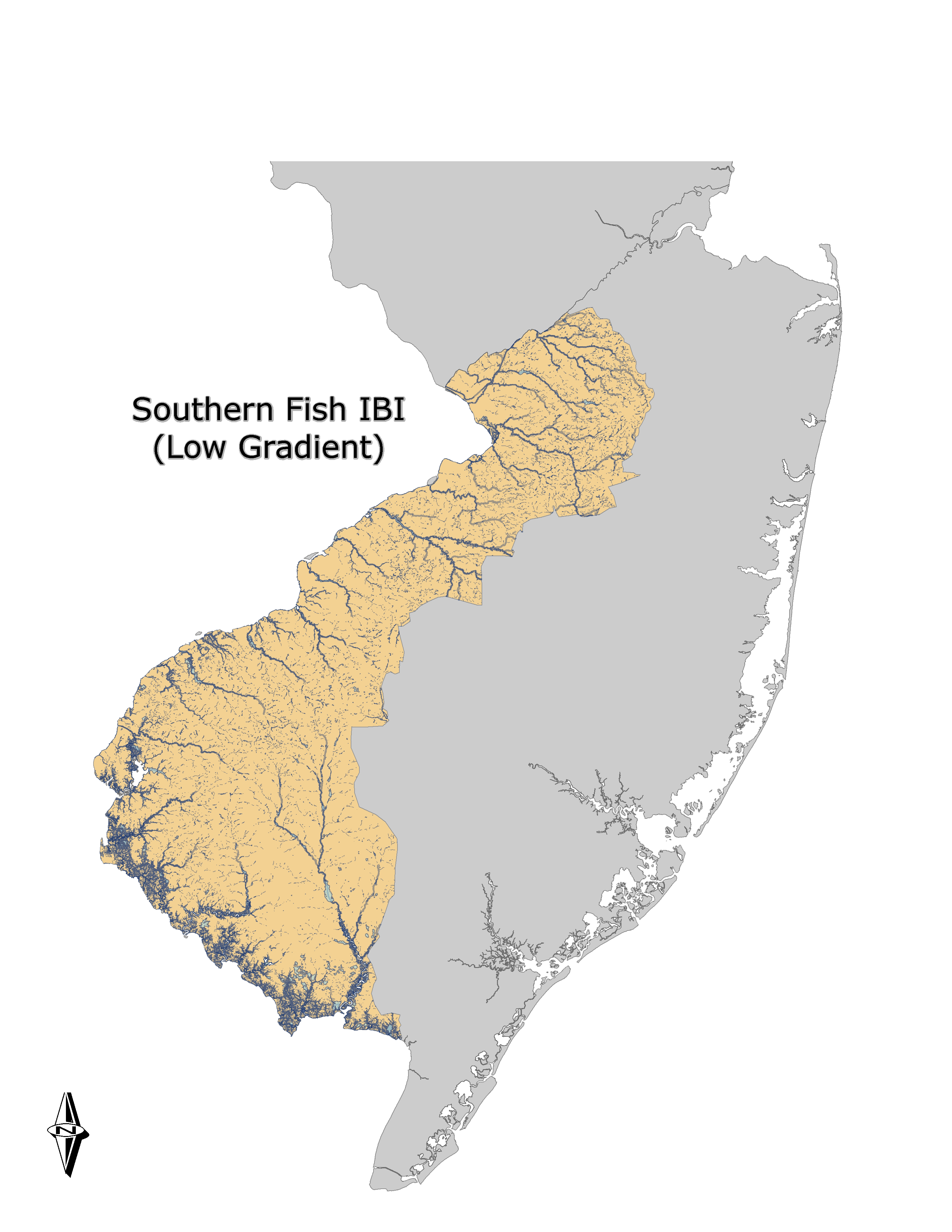
The Fish IBI data is used in concert with available macroinvertebrate data to assess the status of aquatic life designated use in state waters as required by the CWA section 305(b) 106 (e) (1). These data are used to identify impaired waters under section 303(d) 106 (e) (1). The data help to measure water quality use attainment and the Department's success in attaining the Clean Water Act goal of "fishable" waters as elaborated in the New Jersey Integrated Water Quality Assessment Report.
In 2012, the Bureau of Freshwater and Biological Monitoring (BFBM) completed the development of the southern fish IBI for streams in the Inner Coastal Plain. The index is applicable to Delaware River draining streams which are greater than 2 square miles in drainage size. These low gradient waters are home to different fish communities than the high gradient streams and rivers in the northern part of the state. Several unique fish inhabit these sandy, slow moving waters including banded sunfish, swamp darter, tadpole madtom, and mud sunfish.
Similar coastal plain fish IBI’s are being developed or have recently been completed in several Eastern states including: Maryland, Virginia, North Carolina, South Carolina, and Georgia. The development of a fish bioassessment program in coastal plains streams is challenging due to the vast agricultural and urban development in these fragile regions.
The southern IBI incorporates richness, trophic composition, abundance, and overall health of the fish assemblage into a single ecologically based index. The index is comprised of several attributes (metrics) of a healthy fish assemblage, which are selected based on their sensitivity to anthropogenic impacts . Each metric is scored based on its deviation from reference condition. Metrics are averaged to generate an overall score and rating for each stream sampled.
Detailed information related to the methods used to collect fish assemblage, chemical, and physical habitat data for Inner Coastal Plain low gradient streams can be found in the Fish Monitoring Standard Operating Procedures (SOP) This document provides information on fish metrics and the associated scoring methodology for the Southern Fish IBI. In addition, the SOP outlines safety training and procedures as it pertains to electrofishing in wadeable streams.
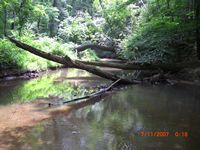
In 2012, the Bureau of Freshwater and Biological Monitoring (BFBM) completed the development of the southern fish IBI for streams in the Inner Coastal Plain. The Southern fish IBI (SIBI) uses resident fish assemblages to measure the health of low gradient wadable streams south of the fall line which are greater than 2 square miles in drainage size. The Southern Fish IBI data is used in concert with available macroinvertebrate data to assess the status of aquatic life designated use in state waters as required by the CWA section 305(b) 106 (e) (1). These data are used to identify impaired waters under section 303(d) 106 (e) (1). The data help to measure water quality use attainment and the Department's success in attaining the Clean Water Act goal of "fishable" waters as elaborated in the New Jersey Integrated Water Quality Assessment Report. Fish assemblage analysis is accomplished using a regional modification of the original IBI (Karr 1981), developed by Vile (2012) that is applicable to Delaware River draining streams.

Fixed sites are sampled on a five-year rotating basis, with monitoring focused on one of the State’s five major Water Regions each year. Southern fish IBI monitoring occurs in the Lower Delaware water region only. Sentinel sites are considered high quality waterbodies located in fully or partially protected watersheds which are sampled on a routine basis to assess environmental changes, natural variability through time, and to evaluate trends in NJ streams. Probabilistic sites are important for assessing aquatic life use in the waters of New Jersey. Probabilistic sites are selected using USEPA probabilistic site selection methodology (Generalized Random Tessellation Stratified (GRTS) survey design).
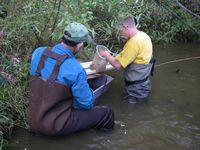
Detailed information related to the methods used to collect fish assemblage, chemical, and physical habitat data for southern low gradient streams can be found in the Fish Monitoring Standard Operating Procedures (SOP) . This document provides information on fish metrics and the associated scoring methodology for the Southern Fish IBI. In addition, the SOP outlines safety training and procedures as it pertains to electrofishing in wadable streams. A summary of the sample types collected from this program include:
| Metric | Ecological Class | Response to Stress | Scoring |
| Native Species Richness | Richness |
Decrease | (Adjusted Value/15)*100 |
| Benthic Species Richness | Habitat | Decrease | (Adjusted Value/3)*100 |
| Intolerant Species Richness | Richness | Decrease | (Adjusted Value/2)*100 |
| % Tolerant Individuals | Tolerance | Increase | ((93.5-Metric Value)/93.5)*100 |
| % Insectivore Individuals | Trophic | Decrease | (Metric Value/61.2)*100 |
| % Piscivore Individuals | Trophic | Decrease | (Metric Value/31.8)*100 |
| Total Fish Abundance Minus Tolerants | Composition | Decrease | (Metric Value/299)*100 |
| Percent DELT Anomalies | Condition | Increase | ((3.4-Metric Value)/3.4)*100 |
Headwaters IBI (High Gradient)
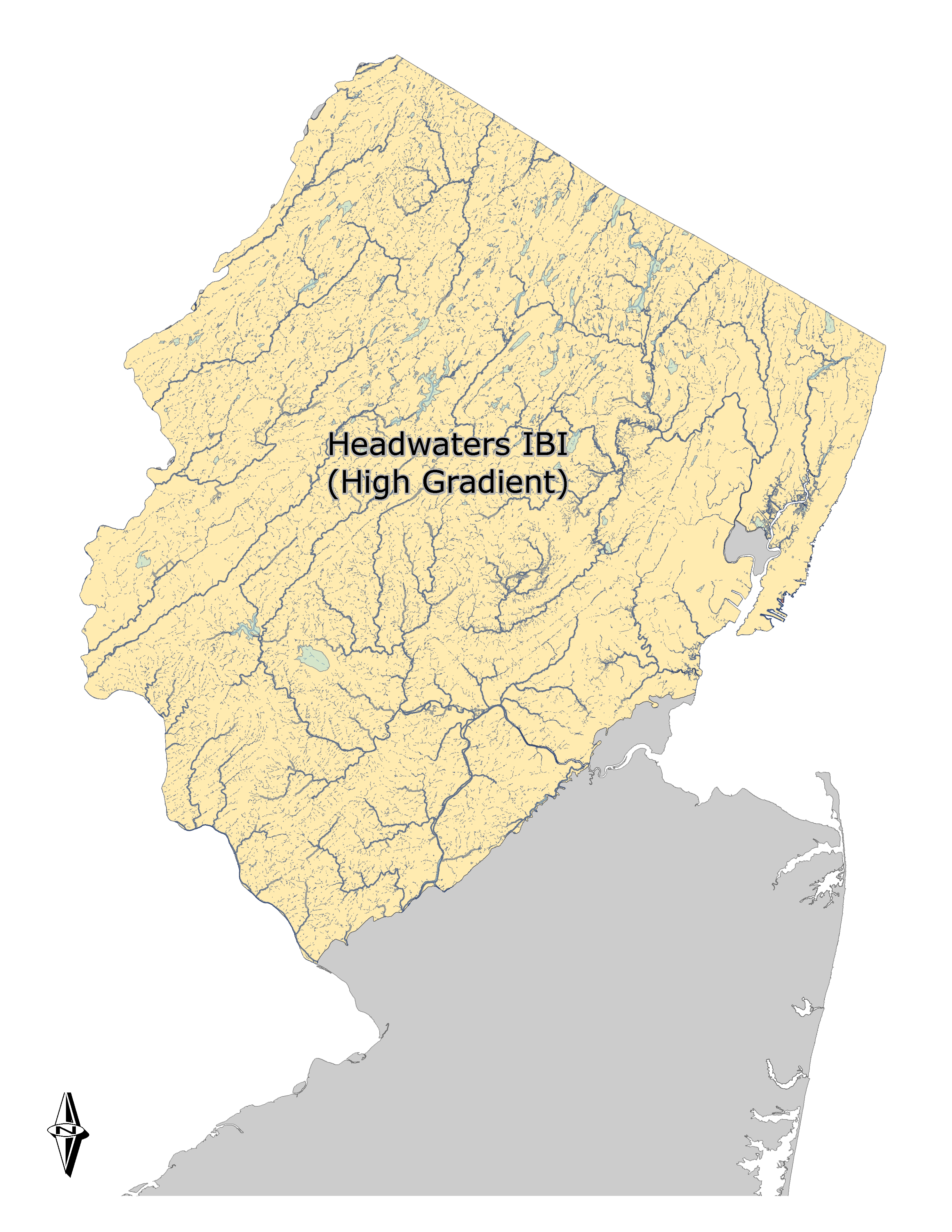
The Headwaters IBI data is used in concert with available macroinvertebrate data to assess the status of aquatic life designated use in state waters as required by the CWA section 305(b) 106 (e) (1). These data are used to identify impaired waters under section 303(d) 106 (e) (1). The data help to measure water quality use attainment and the Department's success in attaining the Clean Water Act goal of "fishable" waters as elaborated in the New Jersey Integrated Water Quality Assessment Report.
In New Jersey, headwater streams account for approximately 80% of the total stream miles in the northern part of the state; of which 38% of the total stream miles in northern NJ are protected by antidegradation designations policies (Outstanding National Resource Waters (ONRW) or Category One waters by the NJDEP Surface Water Quality Standards. In addition to their abundance, headwaters streams provide important ecological services in providing stream flow, transport of organic matter, storage of nutrients, regulation of sediments, and providing vital habitat that supports biodiversity (Lowe and Liken, 2005; Alexander et al. 2007; Meyer et al. 2007; Wipfli et al. 2007). Headwaters are essential to watershed health because they dictate the downstream water quality; however, due to their small size they are highly vulnerable to anthropogenic disturbances and changes in climate (Lowe and Liken 2005, Brooks 2009). The quality of headwater streams typically deteriorates with increasing anthropogenic stress (land development, altered flow regime, pollution, etc.) and results in measured changes in a stream’s biota. The health of these small streams is measured by the Headwaters Fish Index of Biotic Integrity (HIBI), a multimetric index that assesses the overall condition of a headwater stream based on the biological assemblage present within and along the stream corridor.
Headwaters monitoring began in 2014 to complement the existing northern fish IBI program to assess stream condition, water quality and habitat in high gradient headwater streams (typically Strahler stream orders 1-3) north of the geological fall-line with a drainage area less than 4mi2 (10.4 km2). The Headwaters IBI utilizes the assemblage of fish, crayfish, and amphibians present within and along a stream to assess the overall condition of the headwater stream. Taxa other than fish (crayfish, frogs and salamanders) are included in the Headwaters IBI because small order streams often have naturally low fish species richness and cannot be accurately assessed with a solely fish based IBI. Fixed sites are sampled on a five year rotating basis, with monitoring focused on one of the State’s five major Water Regions each year.
Detailed information related to the methods used to collect fish/amphibian/crayfish assemblage data, as well as chemical and physical habitat data for Northern high gradient streams can be found in the Fish Monitoring Standard Operating Procedures (SOP) . This document provides information on fish/amphibian/crayfish metrics and the associated scoring methodology for the Headwaters IBI. In addition, the SOP outlines safety training and procedures as it pertains to electrofishing in wadeable streams.

The Headwater Index of Biotic Integrity (HIBI) uses resident fish, crayfish, salamander and frog assemblages to measure the health of high gradient wadable streams north of the fall line which are less than 4 square miles in drainage size. The Headwater IBI data is used in concert with available macroinvertebrate data to assess the status of aquatic life designated use in state waters as required by the CWA section 305(b) 106 (e) (1). These data are used to identify impaired waters under section 303(d) 106 (e) (1). The data help to measure water quality use attainment and the Department's success in attaining the Clean Water Act goal of "fishable" waters as elaborated in the New Jersey Integrated Water Quality Assessment Report. The headwater taxes collected are analyzed through the multi metric Headwater Index of Biotic Integrity (Vile and Henning, 2018).
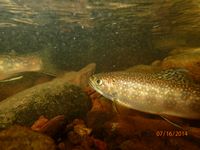
Fixed sites are sampled on a rotating basis, with monitoring focused on one of the State’s five major Water Regions each year (Northwest, Northeast, Raritan, Atlantic, and Lower Delaware). The fixed network for the Headwater IBI are divided amongst the Northwest, Raritan, and Northeast water regions. Sentinel sites are considered high quality waterbodies located in fully or partially protected watersheds which are sampled on a routine basis to assess environmental changes, natural variability through time, and to evaluate trends in NJ streams. Probabilistic sites are important for assessing aquatic life use in the waters of New Jersey. Probabilistic sites are selected using USEPA probabilistic site selection methodology (Generalized Random Tessellation Stratified (GRTS) survey design)
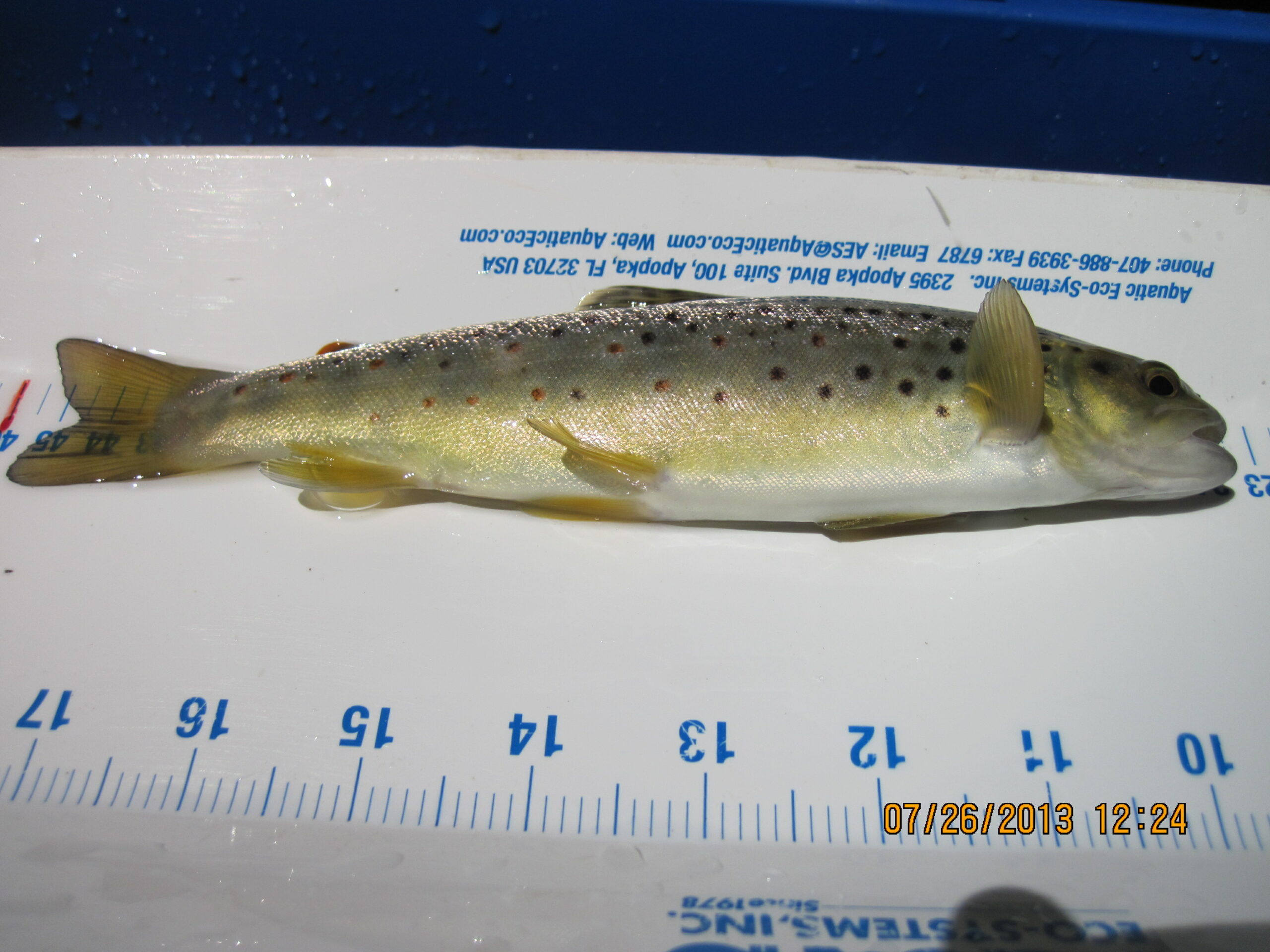
Detailed information related to the methods used to collect fish, crayfish, salamander and frog assemblages, chemical, and physical habitat data for high gradient headwater streams can be found in the Fish Monitoring Standard Operating Procedures (SOP) . This document provides information on fish, crayfish and amphibian metrics and the associated scoring methodology for the Headwater IBI. In addition, the SOP outlines safety training and procedures as it pertains to electrofishing in wadable streams. A summary of the sample types collected from this program include:
| Metric | Ecological Class | Response to Stress | Scoring |
| Intolerant Vertebrate Richness | Richness |
Decrease | (Metric/3)*100 |
| Proportion of Vertebrate Richness as Top Carnivores | Trophic | Decrease | (Metric/38)*100 |
| % Tolerant Fish Individuals | Tolerance | Increase | (96.1-Metric)/(96.1)*100 |
| Proportion of Total Richness as Native | Non-Native | Decrease | (Metric/100)*100 |
| % Native Crayfish | Composition | Decrease | (Metric/100)*100 |
| Brook Trout Density | Composition/Indicator Species | Decrease | (# Brook trout/100m2÷10.1)*100 |
Fish Tissue Monitoring
Fish and shellfish consumption advisories due to chemical contamination were initially issued in New Jersey in the 1980s and 1990’s. Research data from the Division of Science and Research, previously the Division of Science, Research and Environmental Health (DSREH), studies revealed that unacceptable risks existed for eating certain amounts and species of fish and shellfish from selected waters in the State. Additionally, statewide advisories were issued for consumption of certain species. Current advisories are listed on DSR’s Website. Fish tissue data from these and follow-up studies have also been used in the federal Clean Water Act-required assessment of the fish and shellfish consumption use for the State's waters.
The establishment of a regular, annual freshwater fish tissue monitoring program was a key gap identified in NJ’s Long-term Monitoring and Assessment Strategy (2005-2014) . In 2014, NJ’s freshwater fish tissue work began a transition from a research program to annual monitoring, conducted by the Bureau of Freshwater & Biological Monitoring.
In 2016, coastal routine tissue monitoring was started by the Division of Water Monitoring and Standards’ Bureau of Marine Water Monitoring. A copy of the most recent Quality Assurance Project Plan (QAPP) is available from their web site.
Information related to the methods used to collect fish specimens for contaminant analysis and biomonitoring in non-wadeable rivers and lakes can be found in the Fish Monitoring Standard Operating Procedures (SOP) . This document provides information related to boat electrofishing methods and the necessary safety training and procedures.
The objective of the fish tissue monitoring program is to collect data on finfish from New Jersey’s freshwater bodies for contaminants of concern in fish tissue. This program provides current and comprehensive data on concentrations of toxic contaminants in fish to assess human health risks and update/recommend fish consumption advisories. The data is to assess the impairment of the fish consumption designated use of the waterbodies sampled and also to assess the overall status and trends in levels of contaminants that contribute to use impairment and fish consumption advisories.
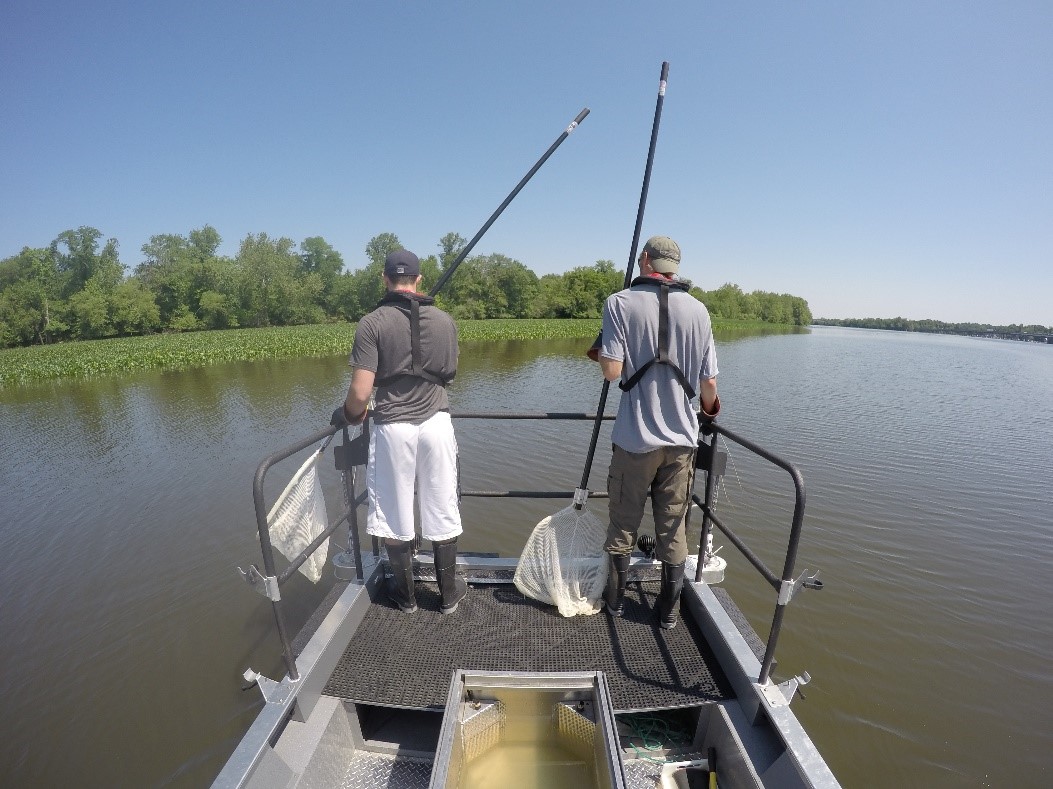
Regional Network – Fixed sites are sampled on a rotating basis, with monitoring focused on one of the State’s five major Water Regions each year (Northwest, Northeast, Raritan, Atlantic, and Lower Delaware). Sampling locations were selected from areas where contaminated fish tissue is of concern and past data is available to assess trends in contaminant levels that contribute to use impairment and fish consumption advisories. These sites are also targeted because they have known fishing access and angling pressure. Additionally, sites were included in watershed HUC14’s that have no previous fish tissue data and thus are deemed “insufficient data” in the New Jersey’s Integrated Water Quality Assessment Reports.
Probabilistic Lake Network – A total of 50 probabilistic lakes (greater than 5 surface acres) were generated using a Generalized Random Tessellation Stratified (GRTS; Stevens and Olsen, 2004) survey design performed using the “sp survey” package (Kincaid and Olsen, 2016) in R (a free software environment for statistical computing and graphics). Lakes that are private (not generally open to public fishing access), tidally influenced, quarry pits (active mining), retention ponds, segments of larger lakes, and waterbodies that do not constitute a “lake” are non-target sites and are not considered for sampling.
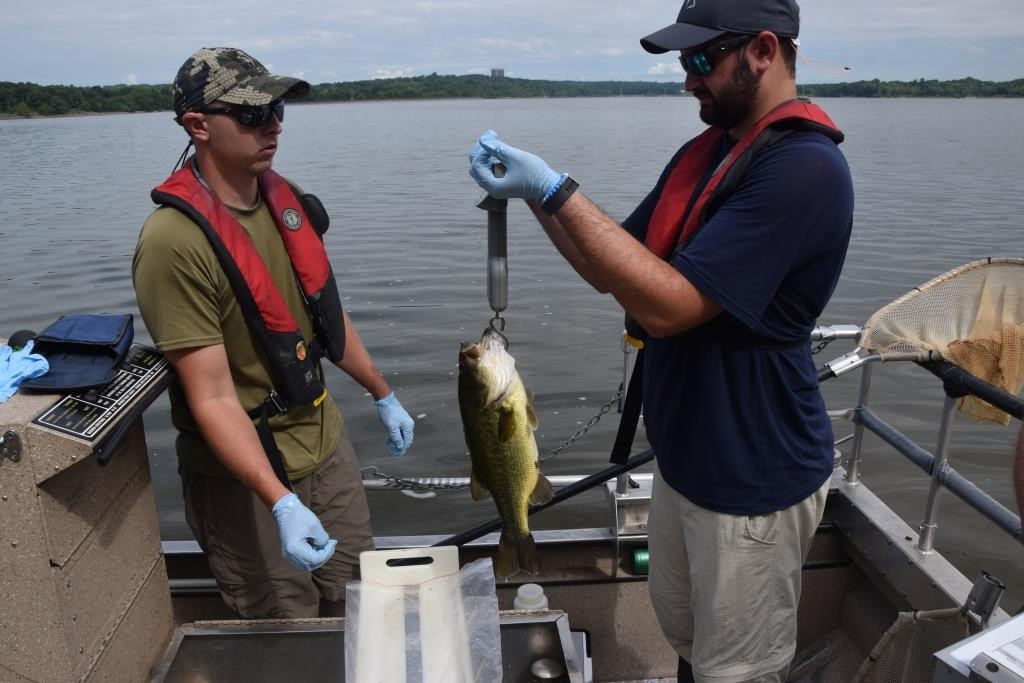
Information related to the methods used to collect fish specimens for contaminant analysis and biomonitoring in non-wadable rivers and lakes can be found in the Fish Monitoring Standard Operating Procedures (SOP). This document provides information related to boat electrofishing methods and the necessary safety training and procedures.
A summary of the sample types collected from this program include:

The freshwater Fish Tissue Monitoring Program employs two types of monitoring designs (Targeted and Probabilistic). The Targeted Regional Network follows a rotating basin approach in which waterbodies are targeted and sampled within a defined water region each year (Figure 1). New Jersey has five water regions that are monitored in the following order (Raritan (2014), Atlantic (2015), Lower Delaware (2016), Northwest (2017), and Northeast (2018)).
Waterbodies are targeted for sampling based on having previous data available for trends analysis, selecting areas of concern and updating advisories. This component of the tissue monitoring program can include rivers and streams, although most waterbodies sampled are lakes and ponds.
The second monitoring design is Probabilistic, meaning that sites are selected randomly, and includes only mercury sampling in publicly accessible lakes. Publicly accessible lakes were selected for the probabilistic design because they often receive more angling pressure, have greater access both to anglers and to sampling staff, and fish movement is generally limited to within each lake. A total of 50 probabilistic lakes (greater than 5 surface acres) were generated using a Generalized Random Tessellation Stratified (GRTS) survey design. This network started in 2016 and is scheduled to be completed in 5 years (2020) by sampling 10 lakes annually. This network utilizes Non-Lethal Fish Tissue Plug Collection methods for mercury sampling by taking a biopsy sample and then releasing the fish alive. This probabilistic monitoring design will provide a statistical statewide status estimate of total mercury concentrations in fish from public New Jersey lakes. These data can also be used over time to assess trends in mercury every 5 years.
eDNA
Environmental DNA (e-DNA) has become a powerful new tool, providing biologists with the ability to track fish species of concern, determine presence/absence of invasive species, and monitor overall fish assemblages. Since fish constantly slough off DNA from their slime layer, scales, excrement, and gametes, DNA can be detected by collecting and filtering water samples. eDNA can then be extracted from filters and analyzed using a variety of laboratory techniques including quantitative polymerase chain reaction (qPCR) and Metabarcoding.
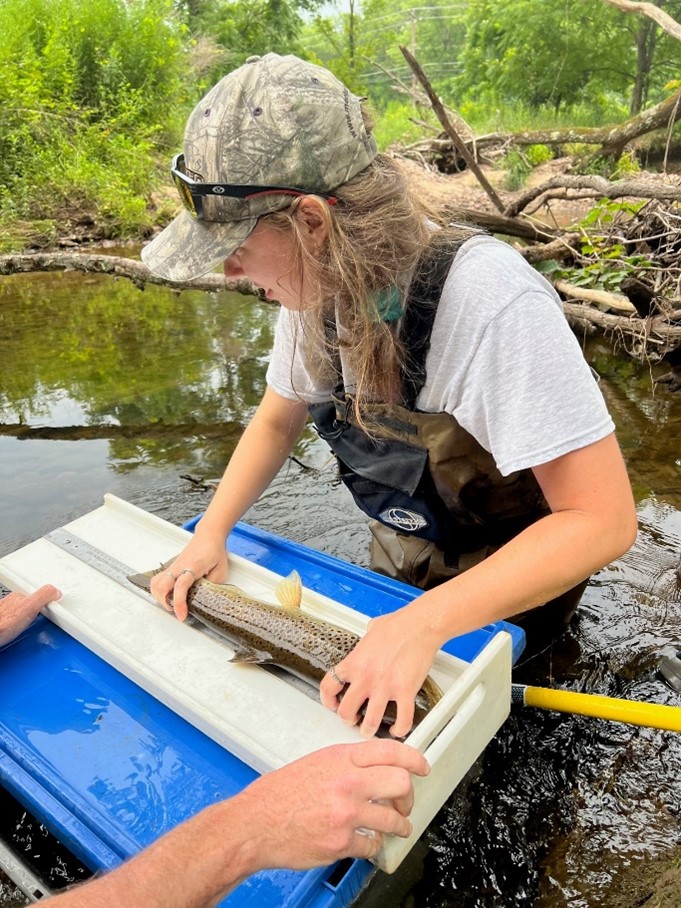

In 2021, the Bureau of Freshwater and Biological Monitoring (BFBM) collaborated with Rutgers University to evaluate eDNA as a potential monitoring technique.. One goal was to collect and develop gene sequencing for all NJ freshwater fish species. Once majority of freshwater fish species were sequenced, BFBM and Rutgers worked to evaluate eDNA’s ability to detect single target fish species, as well as an entire fish assemblage from several rivers and streams using Smith-Root eDNA sampling equipment. Throughout the pilot project, BFBM and Rutgers have honed field collection and laboratory procedures to maximize eDNA detection and prevent cross-contamination. Data collected from eDNA monitoring will complement and support the existing Fish Index of Biotic Integrity (FIBI) program.
American Shad Network
Starting in the spring of 2021, fish biologists from BFBM began collecting water samples from both the Paulins Kill and the Musconetcong River to determine the presence of migrating adult American shad post dam removals. The removal of these dams has reconnected sections of these rivers to the mainstem Delaware River thus allowing passage of migratory fish species. BFBM staff sampled again in summer 2021 using Smith-Root e-DNA sampling equipment to collect, filter, and preserves eDNA samples on-site.
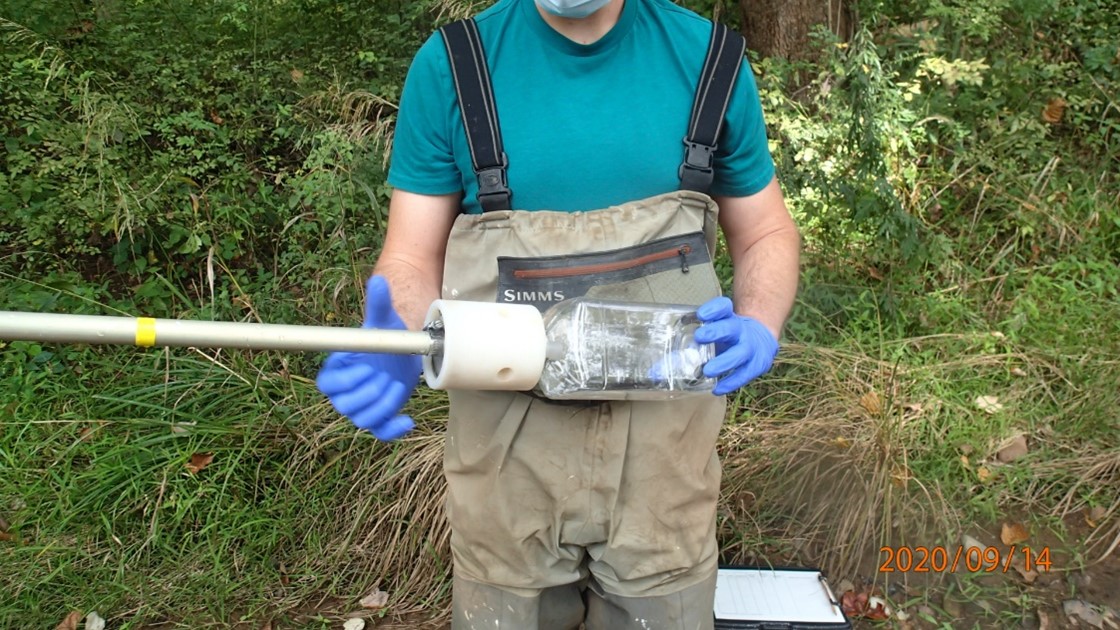
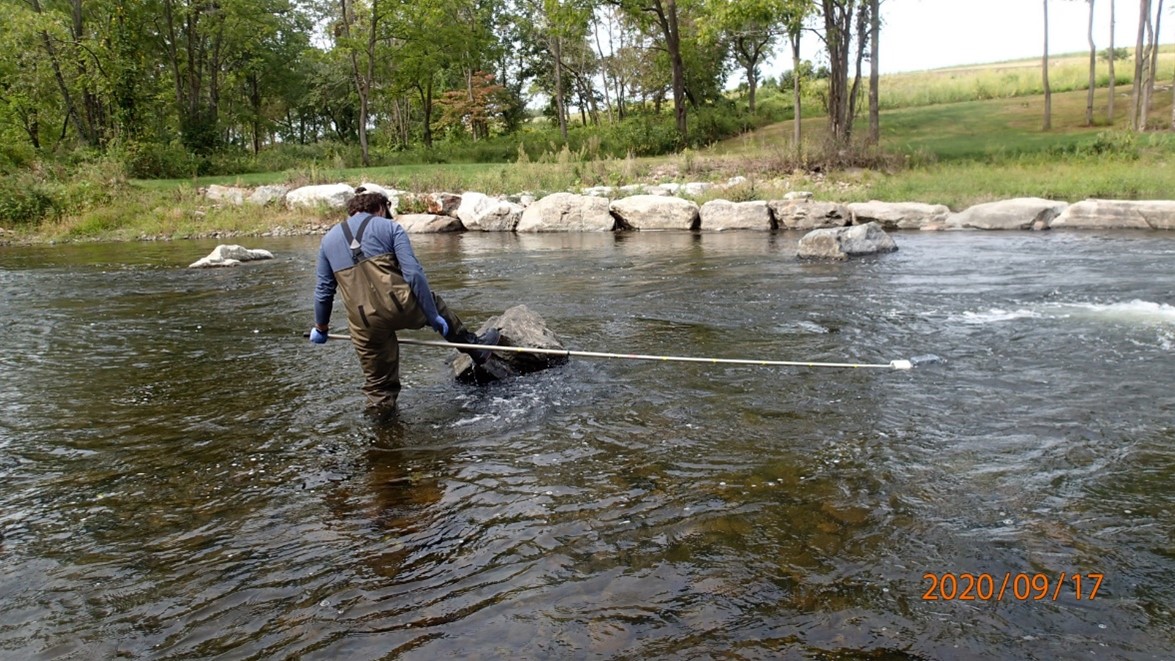
Since 2022, BFBM has continued to monitor the migration of adult and juvenile American shad in the Paulins Kill.

The Paulins Kill drainage, located in Northwest NJ, is a large tributary to the Delaware River making it an important tributary for migrating fish species. The Columbia Dam, built in 1909 at the mouth of the Paulins Kill watershed, has been a fish passage barrier for resident and migratory fish species for over a hundred years until it was removed in 2019. The removal of the Columbia dam in 2019 has once again opened 10 miles of the Paulins Kill to migratory species including American eel (Anguilla rostrata), sea lamprey (Petromyzon marinus), American shad (Alosa sapidissima), and river herring (Alosa sp.).
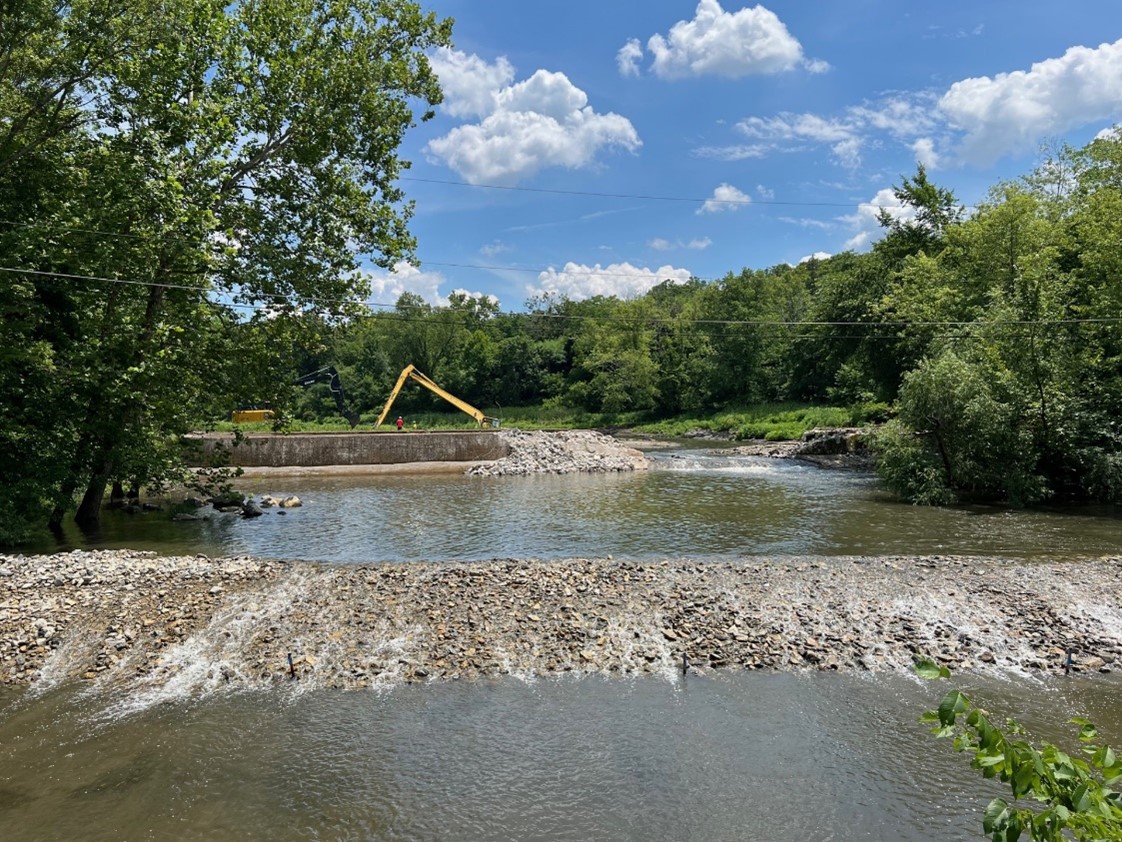
The removal of the Paulina Dam in Blairstown captured in July of 2024
eDNA surveys conducted by NJDEP’s Bureau of Freshwater and Biological Monitoring have detected American shad in the newly restored stretch of the Paulins Kill. Recent Fish IBI (FIBI) surveys collected American brook lamprey and sea lamprey for the first time in the 22 years of monitoring within the watershed. In addition, 2022 FIBI monitoring confirmed an increased abundance of American eel at several long-term monitoring stations in the Paulins Kill drainage.
While monitoring, NJDEP staff captured this video of two sea lamprey spawning in the Paulins Kill at Blairstown Footbridge Park.
Additional eDNA results and information on the eDNA protocols can be found in the eDNA SOP.
IBI Network
In 2022, BFBM started collecting eDNA samples at Northern Fish Index of Biotic Integrity sites. These eDNA samples are analyzed for all fish species using metabarcoding. Results are then compared with traditional electrofishing survey methods to correlate results. BFBM staff are currently working to evaluate species richness, compare fish abundance versus eDNA metabarcoding reads, and determine if eDNA can be included in future biomonitoring protocols.
Find more information about BFBM’s eDNA protocol and results in the links below.
National Rivers and Streams Assessment (NRSA)
National Rivers and Streams Assessment (NRSA) is a federal study organized by the EPA and conducted all over the country. This project occurs on a rotating basis and is conducted for 2 out of every 5 years. During these 2 years, BFBM as well as other organizations across the country conduct thorough stream assessments (which includes physical, chemical, and biological parameters) to assess the ecological condition of the nation’s rivers and streams. Other programs that occur are the National Lakes Assessment (NLA) and the National Coastal Condition Assessment (NCCA). Check out the EPA’s website for more information.

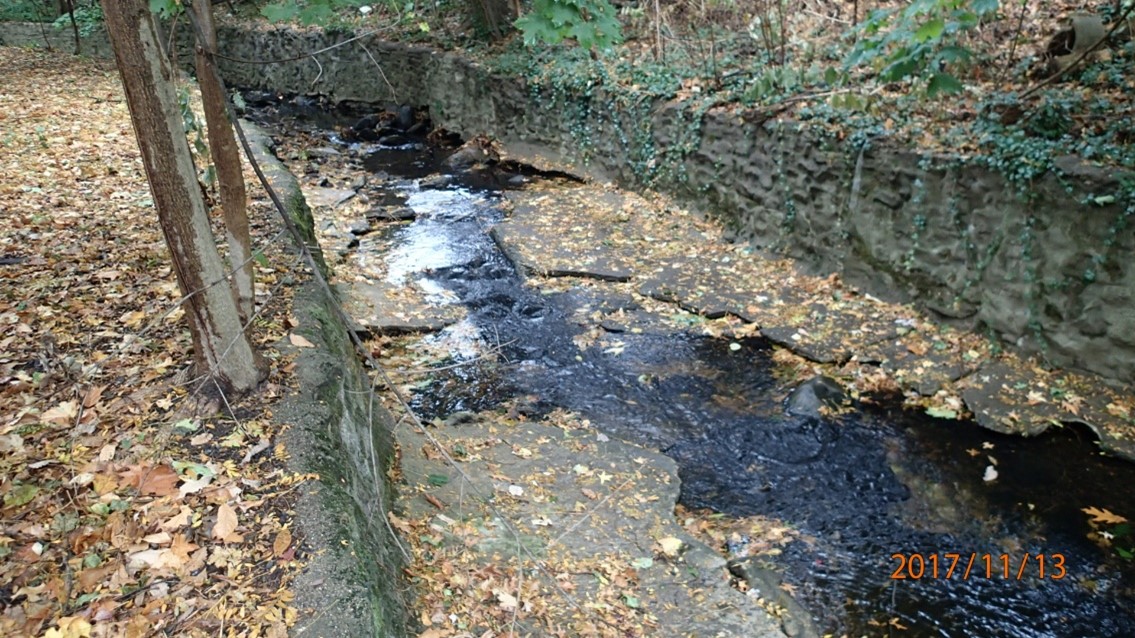
Sentinel Sites
Sentinel sites are part of the FIBI program and have been monitored since 2012. They are considered high quality waterbodies which contain sensitive fish taxa and are located in fully or partially protected watersheds. The Fish IBI program presently has a total of 10 Northern IBI sentinel sites, 10 Headwaters IBI sentinel sites, and 2 Southern IBI sentinel sites that are located throughout the state, each of which are sampled on a routine basis to assess environmental changes, natural variability through time, and to evaluate trends in NJ streams.
Original Northern IBI Sentinel Sites were chosen based on the following criteria:
- Sites must have scored in the “good” or “excellent” Fish IBI rating range
- Recent data must contain at least two intolerant species (hatchery raised trout are not included)
- The initial habitat score must be above 150
- If stocked trout were collected at the site, wild trout must have also been collected at that site
- Percent urban land use must be less than 20%
- Site should have some level of protection i.e. Wildlife Management Area
For more information on each sentinel site as well as other fixed and probabilistic sites, check out the fish mapper.
You can also view or download the MAC-AFS Poster - Mid Atlantic Chapter of the American Fisheries Society 2016 Annual Meeting (Cape May, NJ)

- Headwaters Development DWMS Division Meeting November 20, 2024
- Northern Stream Quality New Jersey Wild Outdoor Expo September 13, 2015
- Southern Stream Quality New Jersey Wild Outdoor Expo September 13, 2015
- Headwaters Stream Quality New Jersey Wild Outdoor Expo September 13, 2015
- FIBI HIBI Development American Fisheries Society 145th Annual meeting in Portland, OR
- MAC-AFS (Sentinel) Poster Mid Atlantic Chapter of the American Fisheries Society 2016 Annual Meeting (Cape May, NJ)
Presentations
- Inner Coastal Plain Pinelands Research Series
- NJ's Fish IBI Programs DWMS Seminar, “Beneath the Surface: What’s Living in Your Streams and What It Means for Water Quality” March 31, 2015
- Headwaters IBI Pinelands Research Series
- Wadeable Rivers & Headwater Streams IBIs January 19, 2017 NJ Water Monitoring Council Meeting
